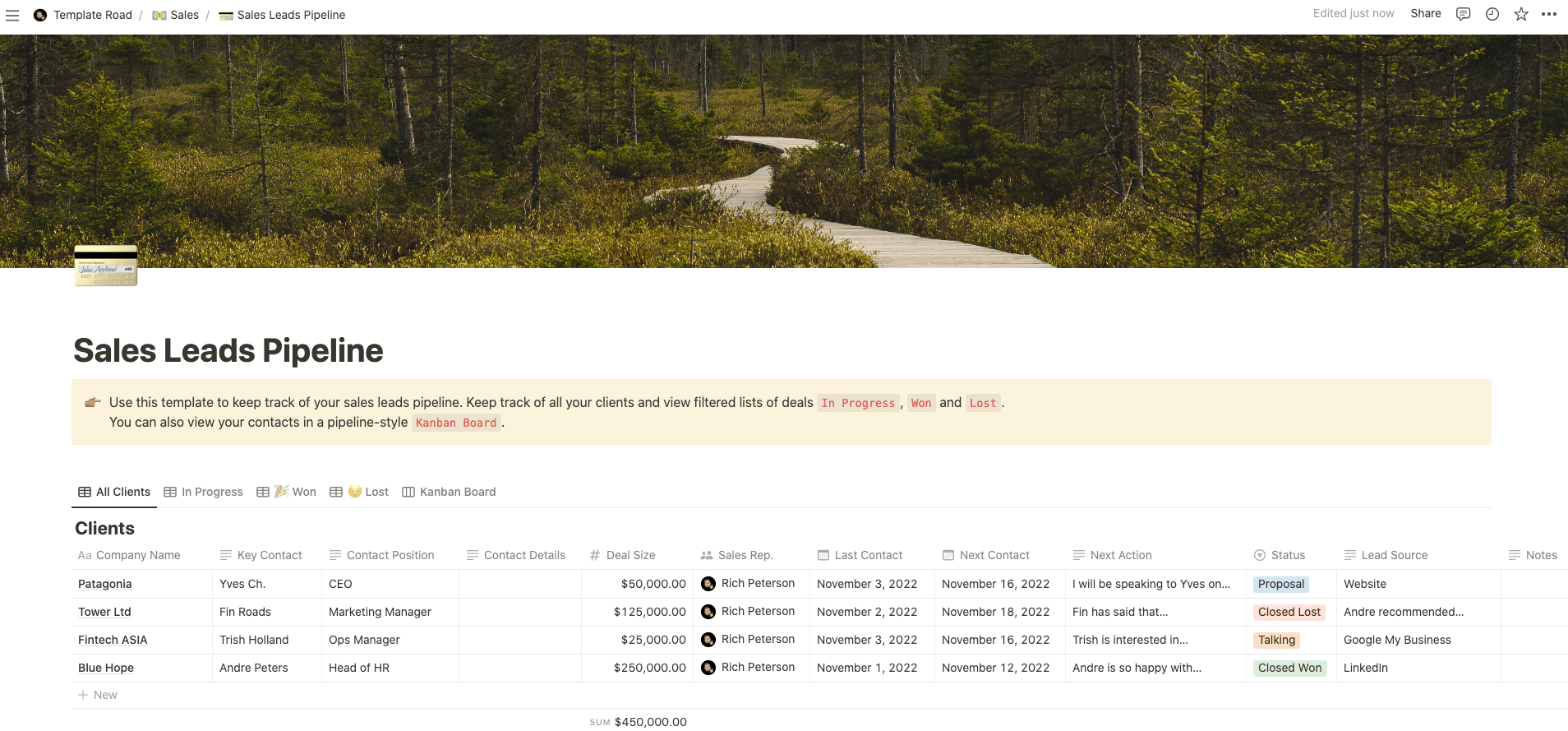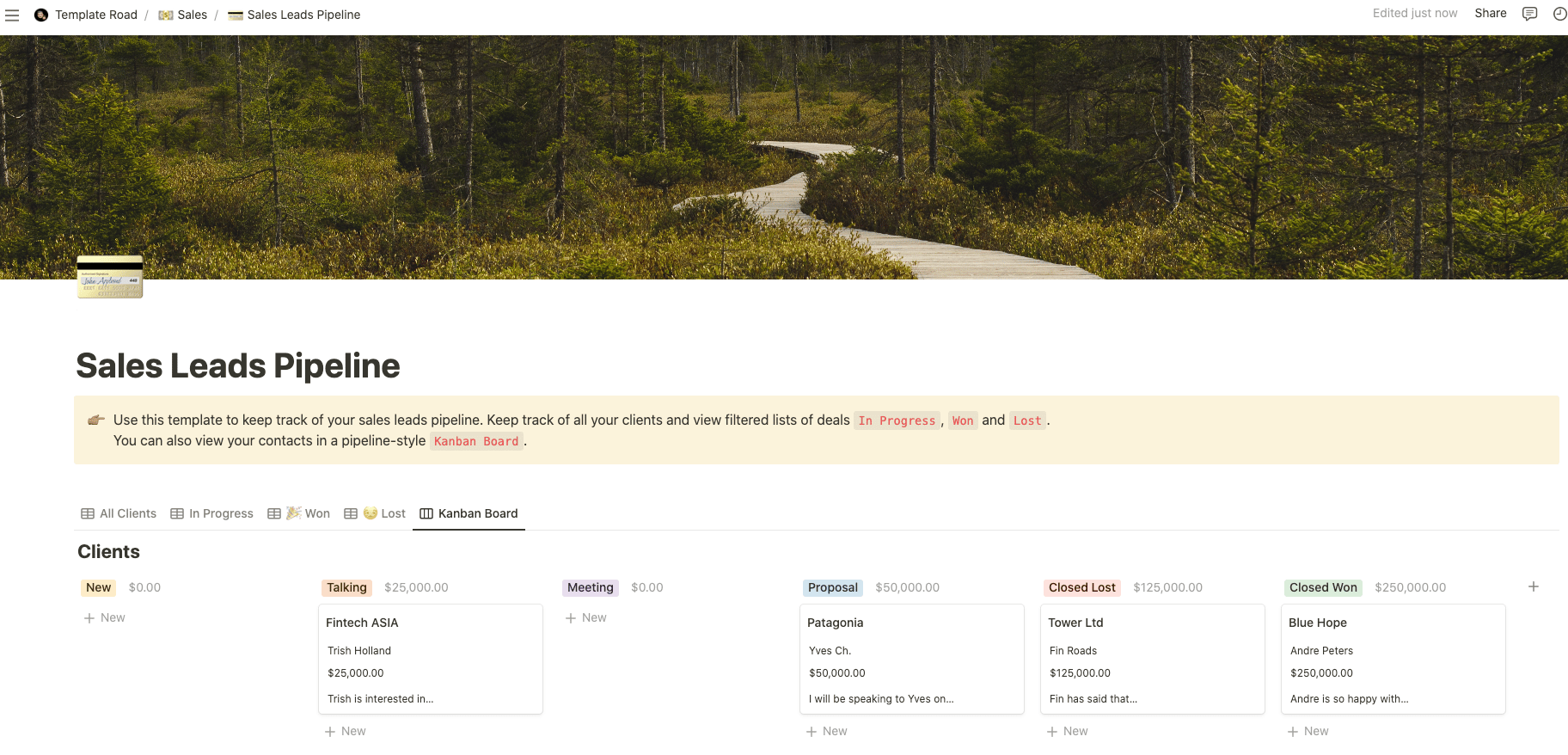Use this template to keep track of your sales leads pipeline in Notion.
Buy on
Contents
Notion – Sales Leads Pipeline
Use this template to keep track of your sales leads pipeline in Notion. Keep track of all your clients and view filtered lists of deals In Progress, Won and Lost. You can also view your contacts in a pipeline-style Kanban Board. A sales lead pipeline is important for any business because it helps you identify which leads are worth pursuing, and also gives you a way to track how well each one converts into a sale. Sales lead pipelines help you prioritize your efforts, and they allow you to measure the effectiveness of your sales team.
——————————————-
What you need before purchase
- Basic knowledge of how to use Notion
- Paid Notion account if you want to add lots of content to your template / Notion account (sign up here). Not much content? You’re able to use their free account.
After purchase, you’ll be able to view the template immediately. The template can be added to your Notion account by:
- Click on the template download link in Gumroad
- When viewing the Notion template, click on the “Duplicate” link in the top-right of your screen
- The template will now be available in your own Notion account
For ongoing use, the steps are:
- Login to Notion and select the template you want to view
- Click on the Duplicate link in the top-right of your screen to create a copy to use
- You’ll be able to retain the Notion template and work on the Duplicate (with a new name) and can repeat this process whenever you want to use the template again
What is a Sales Leads Pipeline Template?
A Sales Leads Pipeline Template is a pre-designed format or tool used to track and manage the progress of sales leads through different stages of the sales process. It provides a visual representation of the sales pipeline, allowing sales teams to organize, monitor, and prioritize their leads effectively. The template helps sales professionals stay organized, identify bottlenecks, and ensure a smooth flow of leads from initial contact to conversion.
Here are some common elements you might find in a Sales Leads Pipeline Template:
1. Lead Information:
– Fields to capture key information about each lead, such as name, contact details, company, and lead source.
– Additional fields to note important details or specific requirements related to the lead.
2. Pipeline Stages:
– Divisions or columns representing different stages of the sales process, such as “Prospect,” “Qualified,” “Proposal,” “Negotiation,” and “Closed/Won.”
– Each stage represents a specific milestone or status that a lead progresses through.
3. Lead Status:
– Labels or tags to indicate the status of each lead within the pipeline stages, such as “New,” “Contacted,” “Follow-up,” “Proposal Sent,” “Negotiating,” and “Closed/Won.”
– These labels help track the progress of leads and determine the next steps.
4. Timeline and Dates:
– Dates or timeframes to indicate when each lead entered a specific stage or when important events occurred during the sales process.
– This helps track the duration spent in each stage and identify any delays or opportunities for improvement.
5. Assigned Salesperson:
– Field to assign the responsible salesperson or team member for each lead.
– This helps distribute workload and ensures accountability.
6. Notes and Communication:
– Section or fields to record notes, comments, or communication history related to each lead.
– This allows sales team members to document important interactions, follow-up tasks, or updates.
7. Metrics and Reporting:
– Metrics or calculations to track important sales metrics, such as the number of leads in each stage, conversion rates, or total revenue generated from the pipeline.
– Visualizations or charts to provide a quick overview of the sales pipeline’s health and performance.
The purpose of a Sales Leads Pipeline Template is to provide a visual and organized representation of the sales pipeline, allowing sales teams to manage and prioritize their leads effectively. The template helps track the progress of leads, identify potential bottlenecks or areas for improvement, and ensure timely follow-ups to maximize conversion rates and revenue.
Please note that the specific elements and design of a Sales Leads Pipeline Template may vary based on individual preferences, the sales process, and the specific requirements of your sales team. It is recommended to customize the template based on your specific needs and adjust the sections or prompts as necessary.
How do I create a Sales Leads Pipeline Template in Notion?
To create a Sales Leads Pipeline Template in Notion, you can follow these steps:
1. Open Notion and create a new page or open an existing one where you want to create the template.
2. Decide on the structure and layout of your template. Consider the elements you want to include in your Sales Leads Pipeline Template, such as lead information, pipeline stages, lead status, timeline and dates, assigned salesperson, notes and communication, and metrics and reporting.
3. Start by adding headings or subheadings for each element. You can use the “/” command in Notion to quickly create different block types, such as headings, subheadings, or bullet points.
4. Under the “Lead Information” section, add fields to capture key information about each lead, such as name, contact details, company, and lead source. Include additional fields to note important details or specific requirements related to the lead.
5. Create a section for “Pipeline Stages” and create divisions or columns representing different stages of the sales process, such as “Prospect,” “Qualified,” “Proposal,” “Negotiation,” and “Closed/Won.” Each column represents a specific milestone or status that a lead progresses through.
6. Add a section for “Lead Status” and add labels or tags to indicate the status of each lead within the pipeline stages. For example, labels like “New,” “Contacted,” “Follow-up,” “Proposal Sent,” “Negotiating,” and “Closed/Won” can be used to track the progress of leads and determine the next steps.
7. Create a section for “Timeline and Dates” and add dates or timeframes to indicate when each lead entered a specific stage or when important events occurred during the sales process. This helps track the duration spent in each stage and identify any delays or opportunities for improvement.
8. Add a field or section to assign the responsible salesperson or team member for each lead. This helps distribute workload and ensures accountability.
9. Include a section for “Notes and Communication” and add a section or fields to record notes, comments, or communication history related to each lead. This allows sales team members to document important interactions, follow-up tasks, or updates.
10. Create a section for “Metrics and Reporting” and add metrics or calculations to track important sales metrics, such as the number of leads in each stage, conversion rates, or total revenue generated from the pipeline. You can also include visualizations or charts to provide a quick overview of the sales pipeline’s health and performance.
11. Customize and refine the template: Adjust the formatting, colors, or styles to make the template visually appealing and easy to read. You can also add additional sections or customize the template based on your specific needs.
12. Save and reuse: Once you have completed your Sales Leads Pipeline Template, save it for future use. You can duplicate the page to create multiple pipeline templates for different sales processes or modify the template as needed for various sales scenarios.
By following these steps, you can create a Sales Leads Pipeline Template in Notion that suits your specific sales management needs. Remember to customize the template based on your requirements and adjust the structure or sections as necessary.












